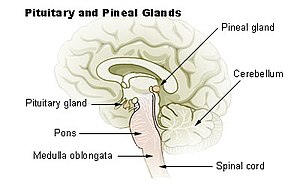Szyszynka

Szyszynka (łac. corpus pineale, syn. glandula pinealis, syn. epiphysis cerebri) – jeden z gruczołów wydzielania wewnętrznego, leżący pomiędzy wzgórkami górnymi blaszki pokrywy. Gruczoł znajduje się w zagłębieniu, pod blaszką czworaczą, kontaktując się z kresomózgowiem szypułą szyszynki.
Powstała z międzymózgowia już u niektórych bezżuchwowców zastępując w całości zadania oka ciemieniowego.
Komórki szyszynki – pinealocyty – produkują tzw. hormon snu, czyli melatoninę. Melatonina i jej pochodne metabolity są wydzielane do płynu mózgowo-rdzeniowego i do krwi. Jego wydzielanie jest ściśle związane z bodźcami świetlnymi – ich obecność hamuje produkcję tego hormonu. U ssaków wywiera także hamujący wpływ na wydzielanie hormonów gonadotropowych, zapobiegając przedwczesnemu dojrzewaniu płciowemu. Czynność wydzielnicza szyszynki przebiega zgodnie z dobowym rytmem zmian oświetlenia i zapewne wpływa na rytmiczność różnych funkcji fizjologicznych[1][2]. U ryb, płazów oraz gadów impulsy docierają do szyszynki bezpośrednio przez kości czaszki, które częściowo przepuszczają światło. U ssaków wydzielanie szyszynki kontrolowane jest przez impulsy wysyłane przez siatkówkę oka. Impulsy te są przekazywane przez tylną część podwzgórza, pień mózgu i rdzeń kręgowy do zwoju szyjnego górnego. Neurony tego zwoju kontrolują wydzielanie hormonu przez szyszynkę.
Zaburzenia w pracy tego gruczołu powodują zachwianie rytmu dobowego oraz w dłuższym okresie zaburzenia w rozwoju gonad.
Stwierdzono, że komórki szyszynki szczurów wydzielają również silną psychodeliczną substancję psychoaktywną o nazwie dimetylotryptamina[3].
Zobacz też
Przypisy
- ↑ Rafael Luboshitzky, Daphna Yanai, Zila Shen-Orr, Ella Israeli, Paula Herer, Peretz Lavie. Daily and seasonal variations in the concentration of melatonin in the human pineal gland. „Brain Research Bulletin”. 47 (3), s. 271–276, October 1998. DOI: 10.1016/S0361-9230(98)00105-1.
- ↑ M. Mila Macchi, Jeffrey N. Bruce. Human pineal physiology and functional significance of melatonin. „Frontiers in Neuroendocrinology”. 25 (3–4), s. 177–195, September–December 2004. DOI: 10.1016/j.yfrne.2004.08.001. (ang.).
- ↑ Steven A. Barker1, Jimo Borjigin, Izabela Lomnicka, Rick Strassman. LC/MS/MS analysis of the endogenous dimethyltryptamine hallucinogens, their precursors, and major metabolites in rat pineal gland microdialysate. „Biomedical Chromatography”. 27 (12), s. 1690–1700, December 2013. DOI: 10.1002/bmc.2981. (ang.).
Bibliografia
- Kazimierz Ostrowski, Wojciech (lekarz) Bem: Histologia. Warszawa: Wydawnictwo Lekarskie PZWL, 1995, s. 542-546. ISBN 83-200-1869-2.
![]() Przeczytaj ostrzeżenie dotyczące informacji medycznych i pokrewnych zamieszczonych w Wikipedii.
Przeczytaj ostrzeżenie dotyczące informacji medycznych i pokrewnych zamieszczonych w Wikipedii.
Media użyte na tej stronie
Star of life, blue version. Represents the Rod of Asclepius, with a snake around it, on a 6-branch star shaped as the cross of 3 thick 3:1 rectangles.
Design:
The logo is basically unicolor, most often a slate or medium blue, but this design uses a slightly lighter shade of blue for the outer outline of the cross, and the outlines of the rod and of the snake. The background is transparent (but the star includes a small inner plain white outline). This makes this image usable and visible on any background, including blue. The light shade of color for the outlines makes the form more visible at smaller resolutions, so that the image can easily be used as an icon.
This SVG file was manually created to specify alignments, to use only integers at the core 192x192 size, to get smooth curves on connection points (without any angle), to make a perfect logo centered in a exact square, to use a more precise geometry for the star and to use slate blue color with slightly lighter outlines on the cross, the rod and snake.
Finally, the SVG file is clean and contains no unnecessary XML elements or attributes, CSS styles or transforms that are usually added silently by common SVG editors (like Sodipodi or Inkscape) and that just pollute the final document, so it just needs the core SVG elements for the rendering. This is why its file size is so small.The Star of Life, medical symbol used on some ambulances.
Star of Life was designed/created by a National Highway Traffic Safety Administration (US Gov) employee and is thus in the public domain.Autor: unknown, Licencja: CC BY 4.0
Descartes: The Nervous System. Diagram of the brain
Rare Books
Keywords: Philosophy; Mathematics; Anatomy; Nervous System; Rene Descartes





